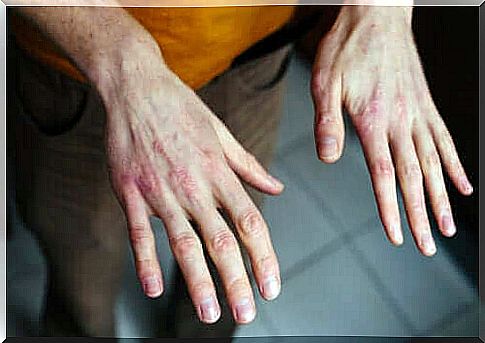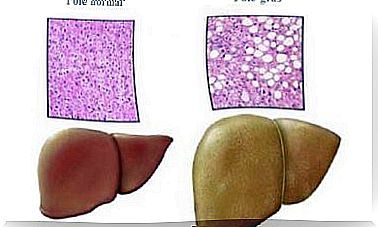Hands Chapped By Cold: How To Treat Them?
Frost chapped hands are very common in winter. Like any other part of the body exposed to low temperatures, the hands suffer from the harsh climate. To learn more, read this article.

The hands chapped by the cold are disabling, because they are irritated and painful. When the winter weather makes the skin rough, the hands are among the first to be affected due to their constant exposure. We use our hands for many activities and cannot always wear gloves to use them.
The hands are covered with skin, and it is this tissue that actually cracks. The skin of the hands has a few hair follicles on its dorsal part with low fat production. The backs of the hands have few protective elements against the cold and are more easily dehydrated.
The situation is different with the palms of the hands, which have more tools to defend against the elements. In addition, the production of sweat is greater, which helps to regulate the temperature.
The winter cold makes your hands chapped because the climate tends to be dry, which dehydrates the cells. A dry dermis breaks at its cell junctions and shows signs of chapping on the outside.
Causes associated with chapped hands
It’s not just the cold that lurks behind chapped hands. Winter brings other conditions associated with cracks, as well as some features unrelated to winter can exacerbate the symptom.
Sudden changes in temperature are one of them. Our indoor environments are heated, sometimes excessively, and when we leave the house or work, our skin experiences thermal shock. This change from heat to cold does not benefit the dermis.
Moreover, as we have already said, cold is associated with drought. However, it can happen that we wash our hands frequently, believing that this way we hydrate the skin. However, this is not always the case. On the contrary, humidity can be counterproductive with the cold environment, increasing cracks.

There are products that we use at home or at work that generate chapped hands, without the intervention of the cold. These are irritants that contribute to the symptoms we are describing. Mention may be made here of detergents, insecticides, lime and certain soaps. As for the latter, versions have been developed that protect cracks instead of making them worse, like surfactant soaps.
Pre-existing diseases are also a factor in cracking, in particular dermatological and autoimmune diseases. People with psoriasis find that their symptoms get worse each winter. Other hormonal diseases, such as hypothyroidism or diabetes, impact the skin.
Measures against cold chapped hands
All is not lost in winter. There are some measures we can take to prevent the hands from chapping due to the cold. We will tell you some of them:
- Washing with lukewarm water : it is absolutely necessary to wash your hands. It is best to do this with water that is neither cold nor hot.
- Use of gloves : when possible, protect your hands with gloves, both for bad weather and irritants. It is important that the skin does not come into direct contact with toxins and that the fingers are kept at a warm temperature.
- Hydration with creams : Not all creams are useful for hands in winter. It is advisable to use those that are specifically formulated to hydrate dry skin, with a compound derived from oats. The application of the compound should not be limited to the skin, but extend to the nails

Useful homemade preparations
As this is not a pathology to be treated with drugs, but with measures and habits, there are home preparations that we can recommend to promote its relief. These formulas are essentially aimed at improving the hydration of the skin and use non-irritating substances.
Some useful homemade preparations include:
- Vaseline : just use it alone, without additives. Vaseline is able to form an insulating barrier on the skin that prevents the entry of cold. It is recommended to apply it once a week
- Wheat : Hot wheat bran is another product that is beneficial for the skin of the hands. It is necessary to prepare a hot boiled liquid, then let stand. Hands can be placed in it several times, making sure this is done over the already hot water
- Honey : Honey has many beneficial properties for the skin. In this case, we know that it can form an insulating layer on the hands. So as not to apply it directly, it is usually mixed with butter, heated and allowed to stand. The problem with this preparation is that it stains what we touch. It is therefore recommended to perform the treatment at times when we do not have to use our hands for other activities.
- Egg : Egg yolk is a natural moisturizer. You can beat it and directly place it on the hands for ten or twenty minutes. Performing this hydration three times a week is more than enough to fight chapped hands due to the cold.
To conclude
The cold seasons provide the necessary conditions to dry out the skin on the hands and increase chapping. To avoid this, hands as much as possible. In addition, we can protect them with certain natural products that help us hydrate them.









